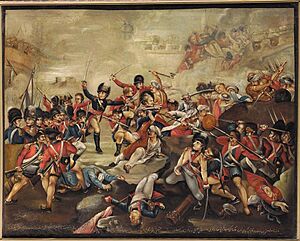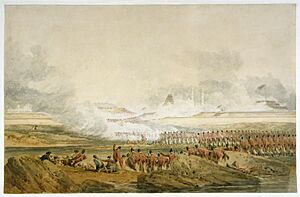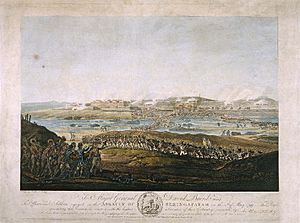Siege of Seringapatam (1799) facts for kids
Quick facts for kids Siege of Seringapatam |
|||||||
|---|---|---|---|---|---|---|---|
| Part of the Fourth Anglo-Mysore War | |||||||
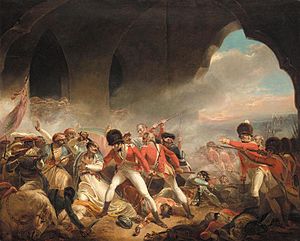 The Last Effort and Fall of Tipu Sultan by Henry Singleton |
|||||||
|
|||||||
| Belligerents | |||||||
|
|
|||||||
| Commanders and leaders | |||||||
|
|
||||||
| Strength | |||||||
| 50,000 |
20,000 soldiers 10,000 volunteers |
||||||
| Casualties and losses | |||||||
| 1,400 killed and wounded | 6,000 to 10,000 killed | ||||||
The Siege of Seringapatam was a major battle that took place from April 5 to May 4, 1799. It was the final big fight in the Fourth Anglo-Mysore War. This war was between the British East India Company and the Kingdom of Mysore in India.
The British, along with their allies, the Nizam of Hyderabad and the Marathas, won a huge victory. They broke through the strong walls of the Seringapatam fortress and attacked the city. Major General David Baird led the British troops. Tipu Sultan, who was the ruler of Mysore, was killed during the battle. After their victory, the British brought back the Wodeyar family to rule Mysore. Krishnaraja Wodeyar III became the new King. However, the British still controlled important parts of the kingdom, like its dealings with other countries.
Contents
The Armies Involved
This battle was a series of fights around Seringapatam (also known as Srirangapatna) in April and May 1799. The combined forces of the British East India Company and their allies had over 50,000 soldiers. They fought against the soldiers of the Kingdom of Mysore, led by Tipu Sultan, who had about 30,000 fighters. The Fourth Anglo-Mysore War ended when Tipu Sultan was defeated and died in this battle.
British and Allied Forces
When the Fourth Anglo-Mysore War began, the British gathered two large groups of soldiers. General George Harris led these groups. The first group had over 26,000 soldiers from the British East India Company. About 4,000 of these were European, and the rest were local Indian soldiers called sepoys.
The second group of soldiers came from the Nizam of Hyderabad. This group included ten battalions and over 16,000 cavalry (soldiers on horseback). In total, the British and their allies had more than 50,000 soldiers. Tipu Sultan's army was smaller because of an earlier war, but he still had around 30,000 soldiers.
Key British Regiments
The British forces included several famous regiments:
- 19th Light Dragoons
- 12th (East Suffolk) Regiment of Foot
- 33rd (1st Yorkshire West Riding) Regiment of Foot
- 73rd (Perthshire) Regiment of Foot
- 74th (Highland) Regiment of Foot
- Regiment de Meuron (Swiss soldiers hired by the British)
Indian Sepoy Forces
The Indian (sepoy) forces fighting with the British included:
- 1st Madras Native Infantry
- 2nd Madras Native Infantry
- 1st Madras Native Cavalry
- 2nd Madras Native Cavalry
- Madras Pioneers
- Madras Artillery
- 1st Bengal Native Infantry
- 2nd Bengal Native Infantry
- Bengal Artillery
The Siege Begins
The British army started to surround Seringapatam on April 5, 1799. The River Cauvery, which flows around the city, was very low at that time of year. This meant soldiers could walk across it, which was important for an attack before the monsoon rains started.
Tipu Sultan seemed to be trying to gain time by asking for discussions. He even said he was busy with hunting trips. Some people believe that Tipu Sultan's chief minister, Mir Sadiq, secretly helped the British. It is said that Mir Sadiq and other officials had been in contact with the English against their ruler.
Breaking Through the Walls
The British Governor-General of India, Richard Wellesley, planned to make a hole in the walls of Seringapatam. The chosen spot was in the western part of the wall, where it seemed weaker.
The Mysorean defenders tried to stop the British from setting up their cannons on April 22, 1799. However, by May 1, the British had finished setting up their cannons on the southern side. These cannons were very close to the wall. On May 2, the cannons from the Nizam of Hyderabad's army successfully made a large hole in the outer wall. Also, explosives placed under the wall went off too early because of cannon fire.
Major General David Baird led the British attack. He had been a prisoner of Tipu Sultan for 44 months many years before. The attacking soldiers, including men from the 73rd and 74th regiments, climbed through the hole in the wall. They fought their way along the top of the walls.
On the night of May 3, some British officers checked the hole in the wall. It was likely during this time that they planned with Mir Sadiq for the attack to happen at midday.
The Final Attack
The main attack was planned for 1:00 p.m. This was the hottest part of the day, when the defenders would likely be resting. Two groups of brave soldiers, called "forlorn hopes," would lead the charge. They would attack the defenses around the hole in the wall. Then, they would turn right and left to take over the rest of the fortifications. A third group, led by Arthur Wellesley, would be ready to help wherever needed.
At 11:00 a.m. on May 4, 1799, the British soldiers were given their instructions. European soldiers also received whiskey and a biscuit. Then, the signal to attack was given. The "forlorn hopes," a group of 76 men, led the charge. The other groups quickly formed up, prepared their bayonets, and moved forward.
As the attack time came closer, Mir Sadiq pulled back the soldiers guarding the hole in the wall. He said he was going to pay them. There was no one to stop this. Sayyid Abdul Ghaffar, a loyal officer to Tipu Sultan, was killed by a cannonball. Right after Sayyid was killed, it is said that traitors in the fort signaled the English troops with a white handkerchief.
The attacking soldiers rushed across the River Cauvery, where the water was about four feet deep. British cannons provided cover fire. Within just 16 minutes, the soldiers had climbed the walls and quickly pushed away the defenders. The British groups then turned right and left, clearing the inside of the walls until they met on the other side of the city.
Tipu Sultan's Last Stand
The group of British soldiers who went around the northwest corner of the outer wall faced a tough fight. A group of Mysorean warriors, led by a large officer, bravely defended every turn. This officer was seen firing hunting weapons that his servants loaded for him.
After the city fell, as it got dark, some British officers searched for Tipu Sultan's body. They found his body in a narrow, blocked passage near the Water Gate. He was identified as the large officer who had been firing hunting weapons at the attackers.
Benjamin Sydenham described Tipu Sultan's body:
wounded a little above the right ear, and the ball lodged in the left cheek, he had also three wounds in the body, he was in stature about 5 ft 8 in (1.73 m) and not very fair, he was rather corpulent, had a short neck and high shoulders, but his wrists and ankles were small and delicate.
He had large full eyes, with small arched eyebrows and very small whiskers. His appearance denoted him to be above the Common Stamp.
And his countenance expressed a mixture of haughtiness and resolution. He was dressed in a fine white linen jacket, chintz drawers, a crimson cloth round his waist with a red silk belt and pouch across his body and head.
He had lost his turban and there were no weapons of defence about him.
What Happened After
All the soldiers who fought with the British in the siege received a special medal from the Governor-General of India.
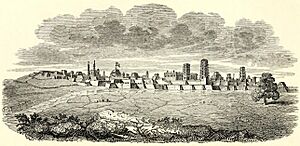
Two cannons captured by the British during the battle are now on display at the Royal Military College, Sandhurst. Tipu's Tiger, a famous mechanical toy, was also taken from Seringapatam and is now in the Victoria & Albert Museum.
Much of the battle site is still there today. This includes the walls, the Water Gate where Tipu Sultan's body was found, and the area where British prisoners were kept. About 80 men from the Swiss ‘de Meuron Regiment’ who died during the siege are buried in the Garrison Cemetery, Seringapatam.
The Siege in Stories
The Siege of Seringapatam has appeared in many stories and plays. Wilkie Collins's novel The Moonstone starts with jewels being stolen from Tipu's treasury after the siege. The battle was also shown in H.M Milner's play "Tippo Saib, Or The Storming of Seringatam" in 1823. In France, the siege and Tipu's death were very popular, as Tipu was seen as a friend of the French. Étienne de Jouy wrote a play called "Tippo-Saëb,tragédie" about it.
The Battle of Seringapatam is also the main conflict in the novel Sharpe's Tiger, written by Bernard Cornwell.
Images for kids
-
Memorial the siege of Seringapatam (1799) by the Mysore government, Seringapatam
See also
- Anglo-Mysore Wars
- Garrison Cemetery, Seringapatam
- Regiment de Meuron
- Seringapatam medal


